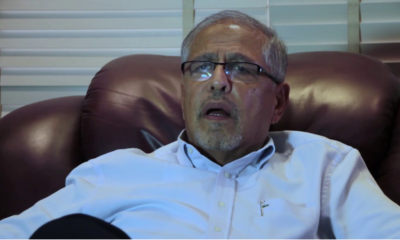News
Kenyan Climber Cheruiyot Kirui Has Died On Mt Everest
The daring mountaineer, had said to reporters of his plans to stretch beyond expected human limits something close to Kenyan marathoner Eliud Kipchoge who broke the record when he became the first human to run a marathon under two hours.

Renowned Kenyan mountain climber Cheruiyot Kirui has died.
Announcing his death, Everest Today, a publication that covers Himalayas, Kirui was found dead just a few meters below the summit point of Mount Everest.
According to the expedition organizers, Seven Summits, Kirui had already hit the 8000m at sea level.
Kirui, a career banker with Kenya Commercial Bank (KCB), had embarked on a risky mission to scale up the world’s tallest mountain and reach the summit without supplementary oxygen.
He was accompanied by a Nepali climber Nawang Sherpa, who also went missing and his fate is still unknown.
Mount Everest has registered a number of tragic deaths in the past and Kirui now adds to the rising numbers. Despite the dangers that that it poses, the adrenaline thrill continues to attract more climbers who’re willing to risk and break the record.
The daring mountaineer, had revealed to reporters of his plans to stretch beyond expected human limits something close to Kenyan marathoner Eliud Kipchoge who broke the record when he became the first human to run a marathon under two hours.
“Climbing Everest has been done before. I think the only difference is what I’m trying to do, climbing without supplemental oxygen. That has not been done by any African. It’s the tough way to climb Mt Everest,” Kirui told reporters.
“It is riskier than climbing with supplemental oxygen. So you need to be extremely fit. The success rate of climbing without supplemental oxygen is less than 40 per cent.”
At 8,849 metres, Everest’s summit has approximately one-third the air pressure that exists at sea level.
This significantly reduces a climber’s ability to breathe in enough oxygen. Because of this, scientists have determined that the human body is not capable of remaining indefinitely above 6,000 metres.
However, Kirui had exuded confidence in the experiment and said it was an easy thing for him to do and beat the odds.
“The challenge for me would be without supplemental oxygen; otherwise, I wouldn’t feel like I’ve achieved much. So I want to see how my body can cope in such altitude,” Kirui said.
“Climbers who ascend higher than 8,000 metres on Mt. Everest enter the ‘death zone.’ In this area, oxygen is so limited that the body’s cells start to die, and judgment becomes impaired.”
He added: “There, your body is not structured to survive with that oxygen concentration, which is around a third of what is at sea level. The idea is that when you are there, you get to the summit as fast as possible and then down before your body starts shutting down or dying.”
Summiting Mt. Everest requires a lot of experience in mountaineering elsewhere, a certificate of good health, equipment and a trained Nepalese guide.
The snow and ice on the mountain create deadly hazards, such as avalanches, and there is only a limited climbing season due to bad weather conditions.
Kirui had said he would conquer that with him being in good shape.
“You have to be in really good shape to be able to get to the summit and down before your body shuts down,” he stated.
Unfortunately, his body couldn’t cope with the conditions.
Kenya Insights allows guest blogging, if you want to be published on Kenya’s most authoritative and accurate blog, have an expose, news TIPS, story angles, human interest stories, drop us an email on [email protected] or via Telegram
-

 News4 days ago
News4 days agoTemporary Reprieve As Mohamed Jaffer Wins Mombasa Land Compensation Despite Losing LPG Monopoly and Bitter Fallout With Johos
-

 Business2 weeks ago
Business2 weeks agoPanic As Payless Africa Freezes With Billions of Customers Cash After Costly Jambopay Blunder
-

 Investigations1 week ago
Investigations1 week agoHow SportPesa Outfoxed Paul Ndung’u Of His Stakes With A Wrong Address Letter
-

 Investigations4 days ago
Investigations4 days agoFrom Daily Bribes to Billions Frozen: The Jambopay Empire Crumbles as CEO Danson Muchemi’s Scandal-Plagued Past Catches Up
-

 News2 weeks ago
News2 weeks agoSCANDAL: Cocoa Luxury Resort Manager Returns to Post After Alleged Sh28 Million Bribe Clears Sexual Harassment and Racism Claims
-

 Sports3 days ago
Sports3 days ago1Win Games 2025: Ultimate Overview of Popular Casino, Sports & Live Games
-

 Investigations1 week ago
Investigations1 week agoInside the Deadly CBD Chase That Left Two Suspects Down After Targeting Equity Bank Customer Amid Insider Leak Fears
-

 Business4 days ago
Business4 days agoHass Petroleum Empire Faces Collapse as Court Greenlights KSh 1.2 Billion Property Auction




















